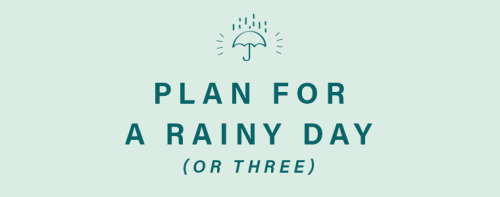Finances are often thought of in terms of short-term and long-term goals: You need to pay the rent on time each month, and you also know you should be setting money aside for retirement. But it’s the medium-term goals—splurgy spends, exotic trips, and make-you-feel-like-a-grownup milestones—that are actually exciting. Chase Slate Financial Education Ambassador Farnoosh Torabi is here to explain how you can take your trip to an otherworldly destination (or buy a house) and build a nest egg, too.

You know you’re technically supposed to be setting money aside for important things like, you know, emergencies and your retirement. Yet, when you’re just getting the hang of budgeting, the cash you’ll need 10 or 20 years from now doesn’t seem like it should be super high on your list of priorities.
But your future can’t wait. And while the idea of adding in yet another layer to your brand-new money management plan can seem overwhelming, it isn’t anything to be intimidated by. Honestly, this is one of my favorite aspects of financial planning, because you get to sit back and really think about the possibilities: What is it you really want out of life, and how can you make it happen?
What is it you really want out of life, and how can you make it happen?
Even if you’re just starting to take charge of your finances, it is possible to keep your eye on the ultimate prize, too, whether you’re looking to travel the world or just retire comfortably.
Here’s how to get in the habit of saving now so you can live the life you want in the future.

Plan for a rainy day (or three)
It doesn’t matter how much debt you’ve paid down or how much unnecessary spending you’ve cut back on—if you don’t have a solid savings foundation, a leaky roof or some surprise car repairs can totally derail all that hard work. You’ll have to keep tapping into those lines of credit, the debt cycle will continue, and whatever it is you’ve got planned for yourself will get kicked even farther down the road.
Which is why your very first savings priority should be building up a solid cash reserve for emergencies. In an ideal world, you’d be paying down any debt you have and putting money in a rainy day fund at the same time. But if your budget is tight, it’s okay to pay the minimums on your cards while you build up your emergency savings. (Promise!)
If your budget is tight, it’s okay to pay the minimums on your cards while you build up your emergency savings.
Rather than setting up a savings account with the same bank that houses your checking account, I recommend setting up an online account. With your money in two separate places, it’ll be less tempting to move cash from your nest egg to your pocket. Some virtual savings accounts do come with ATM cards—and if yours is one of those, toss the plastic! It can take a couple of days to transfer money from your online savings to the account with your brick-and-mortar bank, but that distance is a good thing. The last thing you want to do is break into your emergency savings account on an impulse.
Once you’ve got about $500 in your emergency fund, go ahead and revisit your debt—so long as you’re also still contributing to that rainy day account. You should plan to have six to nine months worth of living expenses at the ready just in case you find yourself unable to bring in income.

Secure your future
When people ask me when they should start saving for retirement, I give them my standard (and probably frustrating) answer: yesterday. So few of us really grasp how much of an advantage you gain just by starting a little earlier than everyone else.
Whether you choose to participate in your company’s 401(k) plan or save on your own with an individual retirement account (IRA), ideally, you should be contributing between 10 and 20 percent of your take-home pay to retirement. And the earlier you begin pouring money in, the better. In fact, the timing can actually be more important than the size of your initial investment.
Here’s some math: Financial models show that if a 25-year-old starts investing today and saves $10 a day for the next 10 years, then stops and allows that money to grow and earn interest over the next 25 or 30 years, this person will have more money than somebody who didn’t start investing in their 20s, who maybe started at 35 with that same $10 a day. The power of compound interest is real.

Get what you want
Emergency and retirement savings are non-negotiable. But once you’ve paid your bills, saved for a rainy day, and started building a nest egg for retirement, it’s time to start working towards the fun stuff. Do you want to go back to school, or have enough cash for a down payment on a home, or take a sabbatical from your job to travel the world? Whatever your medium-term goals are—by medium-term, I mean goals you’d like to accomplish five or 10 years from now—begin by setting up separate savings “buckets” for each.
Do you want to go back to school, or have enough cash for a down payment on a home, or take a sabbatical from your job to travel the world?
I like CDs, or certificates of deposit, over traditional savings accounts for savings you’ll want to tap into in a few years. With a CD, you place your money in an account for an agreed-upon period (that can range from a few months to five years or more, depending on the terms) and let it sit there and grow with interest. (You can’t withdraw anything before the end of the term without incurring penalties, but that’s just another incentive not to dip into your savings on an impulse!) The up-side to those strict terms is that, because you’ve committed to keeping your money in the bank for a relatively lengthy period of time, you’ll be able to take advantage of much higher interest rates than with your standard savings account.
Throughout it all, you should be keeping as close an eye on your medium- and long-term savings as you do on your daily spending. Sign up for daily text updates from your bank to keep tabs on your account balances or for a heads-up when your balance drops below a certain amount. Though alerts like that are, for the most part, intended to keep you on the straight and narrow, they can also provide some much-needed positive reinforcement. It’s kind of fun to watch your savings grow over time and know you’re that much closer to the life you want.
Farnoosh Torabi is one of America’s leading personal finance authorities. From her early days reporting for Money magazine to hosting a primetime series on CNBC to becoming a Chase Slate Financial Education Ambassador, she’s become a go-to money expert. Millions of Americans tune into Farnoosh’s award winning podcast, So Money, and her work and advice have been featured in The New York Times, The Wall Street Journal, O, The Oprah Magazine, Fortune, Forbes and Time. For more, check out www.Farnoosh.TV.
Make 2018 your healthiest, happiest, and richest yet—with a little help from Well+Good’s (Re)New Year program!
Sign Up for Our Daily Newsletter
Get all the latest in wellness, trends, food, fitness, beauty, and more delivered right to your inbox.
Got it, you've been added to our email list.

















